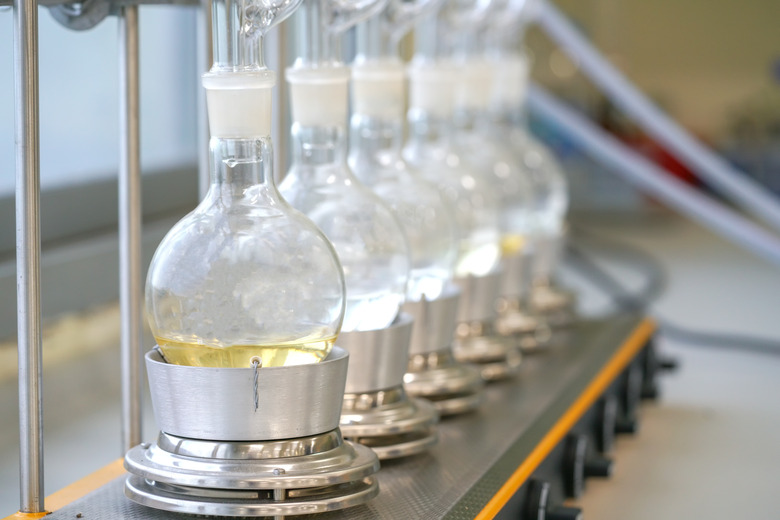Principles Of Steam Distillation
Steam distillation removes contaminants from water to make it essentially inert. Laboratories and technicians use distilled water for this reason, as it doesn't add anything to the component being tested. Distilled water does not have any minerals in it, which makes it unsuitable for drinking, but good for aquariums, essential oil extraction, scientific experiments and more.
TL;DR (Too Long; Didn't Read)
The process of steam distillation separates the substances of a mixture through evaporation, which then involves condensing the vapor back into liquid, taking advantage of the fact that different elements or compounds have different boiling points. It has wide uses, from water purification to extracting oils from organic matter and refining crude oil.
Reasons for Steam Distillation
Reasons for Steam Distillation
Traditional distillation techniques require direct heating of the mixture to evaporate its contents. While this works well for most inorganic solutions and a few organic ones, there are many organic compounds that decompose at high temperatures, including many natural essential oils and aromatic compounds. To ensure the needed organic compounds do not get destroyed during steam distillation, technicians distill these compounds at lower temperatures.
Vapor Pressure
Vapor Pressure
Matter surface has high energy molecules in contact with the atmosphere, which exert a certain pressure against the atmosphere due to their internal energies, known as vapor pressure. If this pressure exceeds the atmospheric pressure, those molecules evaporate. Since heating increases the internal energy of those molecules, it also increases vapor pressure.
How It Works
How It Works
Most complex organic compounds don't dissolve in water but form a mixture instead, which separates if allowed to settle as the water settles down and the organic compounds float on top. The steam distillation process works on the principle that when a mixture of two or more undissolved liquids are heated, while ensuring that the surfaces of both liquids are in contact with the atmosphere, the vapor pressure exerted by the system increases. This is because it now becomes the sum of the vapor pressures of all of the components of the mixture combined together. This allows for evaporation of elements with high boiling points at much lower temperatures merely by allowing them to form a mixture with water.
Extraction Procedure
Extraction Procedure
Steam passes through the organic matter that contains the compounds for separation. The steam condenses against that matter to form a mixture. That mixture gets heated further by more incoming steam, which continues to pass through the matter, evaporating the mixture. Due to the reduced vapor pressure, the required organic compounds also evaporate as a part of the mixture and are thus extracted from the organic matter.
Separation Procedure
Separation Procedure
The evaporated mixture of steam and the organic compounds passes through jackets that have cold water coming in at one end. The evaporated mixture then passes out as hot water from the other end after cooling the mixture down. This condenses the mixture, which is then collected and allowed to settle. During the settling process, the extracted organic compounds come to the top, and they are then separated by filtering out the settled water from below.
References
Cite This Article
MLA
Alo, B.T.. "Principles Of Steam Distillation" sciencing.com, https://www.sciencing.com/principles-steam-distillation-6129502/. 17 May 2018.
APA
Alo, B.T.. (2018, May 17). Principles Of Steam Distillation. sciencing.com. Retrieved from https://www.sciencing.com/principles-steam-distillation-6129502/
Chicago
Alo, B.T.. Principles Of Steam Distillation last modified March 24, 2022. https://www.sciencing.com/principles-steam-distillation-6129502/
